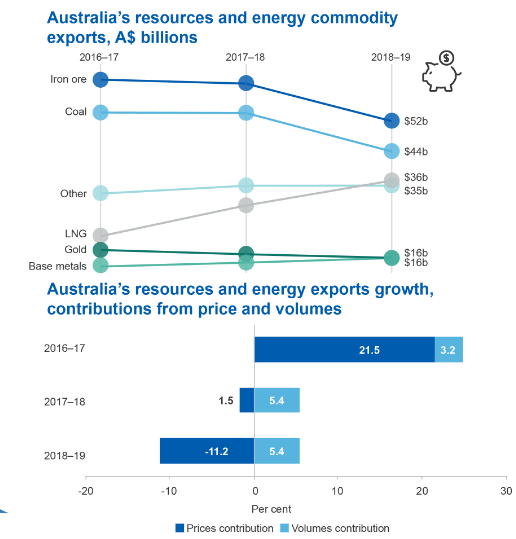The Department of Industry, Innovation and Science have released their latest report and forecasts into commodities, doubling down on the “small correction, then steady plateau” meme.
From the ABC:
In 2018-19 earnings are forecast to fall to $200 billion, driven by declining iron ore and metallurgical coal prices.
The expected 7 per cent fall in export earnings is due to declining commodity price forecasts.
While the forecasts tip resources and energy export volumes to continue to grow at a robust pace over the next two years, it will not be enough to offset lower prices.
Prices are forecast to decline by 2 per cent in the current financial year and by a further 10 per cent in 2018-19.
Resources analysts Gavin Wendt from MineLife said the department appears to be erring on the side of caution with its latest forecasts.
“I think they’re probably being a little bit conservative in terms of the overall outlook for the resource sector,” he said.
Iron ore prices held up better than expected in 2017, but the department expects a decline in export volumes and earnings into 2018-19. Growth in China’s steel sector supported iron ore prices last year, but that’s expected to slow this year and next.
A very conservative forecast that is going to strip away at least $21 billion in earnings as iron ore and coal export volumes top out:


Luckily the country has a robust manufacturing sector plus plenty of government financial bullets in the chamber to offset this fall….
Oh wait, there’s LNG!
Between 2016–17 and 2018–19, LNG is expected to add $14 billion to Australia’s export earnings.
Growing LNG export volumes, attributed to the completion of the three remaining LNG projects currently under construction — Wheatstone, Ichthys and Prelude — will underpin growth in LNG export earnings out to 2018–19.
So only $7 billion lost – if – prices come off the boil only slightly from the current meltup rally. The real problem is the massive capex hole that is left in the economy after these projects are completed later this year, with absolutely zero signs of non-mining investment picking up any of the slack:

The mining boom is dead. And the holes left in the economy are too deep to patch up with services or the nearly dead manufacturing sector, nor any further fiscal or monetary stimulus.
Australia better hope there’s no external shock or price collapse in commodities in the next few years.
